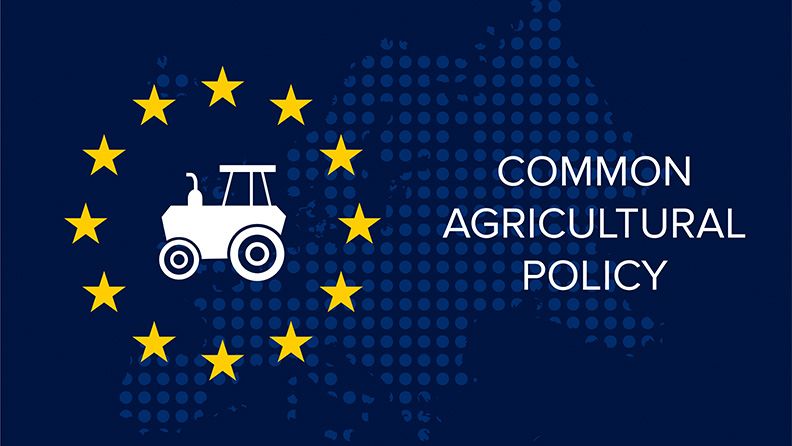
22 July 2025
The Vision on Agriculture and Food issued on March 2025 by the European Commission proposes, as one of its main points, targeting income support at those farms that need it most. However, it does not elaborate on the criteria for such targeting, except to mention that they must be active farmers and that those most needed farmers are young farmers, new farmers, farmers in disadvantaged areas, and farmers with mixed farms. In a sense, the Vision represents a step backward from the outcome of the Strategic Dialogue on the Future of EU Agriculture launched by the Commission President in January 2024 and whose conclusions published in September 2024 identified the economic viability of farms as a key criterion for targeting income support.
The purpose of this note is precisely to propose a general model for targeting income support in the future Common Agricultural Policy (CAP) based on two criteria: active farmer status and the economic viability of the farm. Regarding the first criterion, active farmer status, it is proposed that a rule be adopted in the future CAP, at EU level and therefore applicable to all Member States, to define an active farmer as one who derives at least 20 % of their income from farming.
Regarding the second criterion, economic viability, income support should focus on farms that can become profitable or are already profitable, but whose profitability is not assured without public support.
In order to make this criterion operational, it is based on the existence of significant economies of scale in agriculture, as shown by the Farm Accountancy Data Network, so that the economic profitability of farms depends largely, although not exclusively, on their economic size measured as Standard Output (SO). This would make it possible, without the need for the Commission to establish a methodology and standard indicators of profitability, which would be complex, to focus income support on the economic size of farms. Economic size could therefore be taken as a proxy for farm profitability. There may be some very small farms that are profitable and some large farms that are not, anyway these cases will undoubtedly be exceptional cases. The validity of taking economic size as a proxy for farm profitability will be discussed later.
Farmers below a certain threshold would not be economically viable, either currently or potentially, and should therefore be excluded from income support. In any case, most of them are not active, i.e., they are part-time or multi-active farmers or are retired.
On the other hand, farms above a certain economic size threshold are very profitable, so they do not need income support, although they could access environmental aids and investment support (modernization, innovation, digitization, renewable energies, marketing, etc.). Figure 1 represents the proposal to target income support according to the economic size of farms (the function shown is purely theoretical for illustrative purposes)
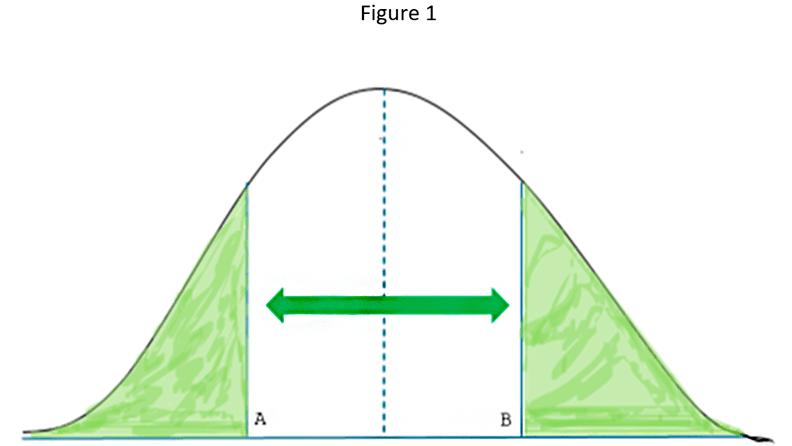
In Figure 1, farms in the two green areas would be excluded from income support, which would therefore focus on farms in the uncoloured area between A and B, considering that the majority of them would be active farmers. The practical problem is to establish the economic size thresholds, points A and B. Given that the agricultural structure is very different in each Member State, it would be reasonable to leave it up to them, taking into account the EU regulation guidelines. The two criteria, active farmer and economic viability (farms between A and B) should be combined, i.e., only farmers who meet both criteria would receive income support.
The proposal to target CAP income support based on economic viability has at least two main problems. First, the economic dimension is just a proxy for farm profitability. The accuracy of the proxy will depend on the definition of thresholds A and B. It is clear that the economic dimension is a good proxy if A is a very low threshold and B is a very high threshold. It is unlikely that a farm with a very small economic size be profitable and with a very large economic size not be profitable. Second, setting an economic size threshold B may cause a “border effect”, with farms exceeding B trying to divide their farm, or being disincentivised to increase their size. Two elements can be deduced from the above: 1) again, the importance of defining thresholds A and B; and 2) it might be better to cap income support than to exclude larger farms (to the right of B) in order to avoid, or at least discourage, the border effect.
One strong reason to propose targeting income support is that the high EU budget allocated to this has been criticised for lacking legitimacy. Other productive sectors also facing major crises do not receive this kind of income support. In addition, the redistributive impact of income support has been negative. Since the aid is based on hectares, most of the budget goes to the largest farms. This has been addressed through redistributive payments and capping, but it has not been enough. There has also been an attempt to legitimise this aid through stronger environmental conditionality and eco-schemes. However, this has created problems in defining environmental requirements and it has also increased bureaucracy and controls. These demands have been criticised and have led to protests from farmers.
For all these reasons, and in addition to the proposal of moving from environmental conditions to incentives, as suggested in the Vision, we believe that the best way to respond to criticism is to focusing income support, as the Vision also proposes, although without specifying how. An alternative to targeting, or a complementary option, would be to make the income support degressive or to transform all or part of this income support in investment support i.e. incentives and aids for farm modernisation and innovation.
The main idea behind the proposal to target income support is to allocate the public expenditure savings from targeting income support to measures that promote innovation, improvement, and modernization of the agriculture to make it more sustainable and competitive. It means a progressive shift from income support to investment support (preserving the environment, conserving biodiversity, mitigating climate change, modernization, innovation, digitization, renewable energy generation), whether the investment be made individually, corporately, or associatively.
Comparing our proposal with the Regulation proposal on targeting income support
This note was written on April 2025 after the Vision and before the proposal for a Regulation establishing the conditions for the implementation of the Union support to the Common Agricultural Policy (CAP) for the period 2028-2034, issued on 16 July 2025. The comparison between the conceptual proposal in this note and the provisions from the Regulation proposal concerning targeting income support can cab be summarized in the following points
- The two proposals are consistent with the same principle i.e. income support must be targeted at those farms that need it most, following two criteria: active farmer and farm economic viability. Nevertheless, the Regulation proposal change the wording economic viability, as mentioned in the conclusions of the Strategic Dialogue, for “economic vitality” as mentioned in the Vision and now in Page 2 of the explanatory memorandum of the Regulation proposal. We don´t know ironically if the change is due to a spelling mistake or it is intentional. Anyway, the Regulation proposal establishes that the income support per eligible hectare shall be differentiated by groups of farmers or geographical areas. The differentiation of income support shall be established based on farmers’ income from agricultural activity in a representative reference period. However, to know the farmer’s income for a reference period is not an easy task and thus a proxy should be used for simplification.
- The main instrument to targeting income support from the Regulation proposal is the strongly degressive area-based income support and the capping at 100.000 € of income support payment (article 6). The application of this instrument allows the treatment of the farms to the right of point B in our note, although in a different way. The two main differences are first that we use the economic size as a proxy of economic viability (income), while the Regulation proposal uses the income support amount as a proxy of economic viability (income). In fact, there is a strong correspondence between the income support size and the economic size of farms. Second, we propose a threshold method (points A and B to be defined by each Member State) while the proposal of Regulation proposes a gradual method (reduction of the income support amount at several points 25,000, 50,000 and 75,000 € of income support amount) and capping at 100.000 € for all Member States.
- Concerning the farms to the left of point A there are clear differences on the treatment of these farms between the proposal from our conceptual note and the provisions from the proposal of Regulation, but the practical results of both proposals are rather similar. The article 6 of the Regulation proposal establish that “Member States shall target the support at farmers who are the most in need, in particular young and new farmers, women, family or small farmers, farmers combining the production of crops and livestock or farmers in areas with natural or other area-specific constraints”. The mention to the family or small farms in the list of farmers who are the most in need for income support has been now introduced in the Regulation proposal, as that mention did not appear in the Vision. We interpret this Regulation proposal novelty as a political concession to the farmer organizations. Apparently, the mention to the small farmers in the Regulation proposal as farmers who are the most in need for income support, is contradictory with our proposal to exclude to the small farms to the left of point A from income support. Nevertheless, is just apparently because it depends on the definition of the point A threshold.
- In addition, the Regulation proposal has two provisions that in practice excludes many small farmers from receiving the income support aid. In that sense, the point 5 of the article 6 of the Regulation proposal establishes that “The Member States shall ensure that the support under this Article is primarily directed towards farmers who exercise an agricultural activity on their holding and actively contribute to food security. Small farmers, whose principal activity is not agriculture, but who are engaged in at least a minimum level of agricultural activity, as set out by Member States, shall be considered farmers as well”. Of course, most of the smallest farmers will be non-active farmers but the drafting of this provision open the door to the Member States to widening the scope of small farmers who are active farmers through a generous definition of that minimum level of agricultural activity. It is another political concession to the Member States The second provision (point 6 of article 6 of Regulation proposal) is much clear and strict. It establish that “Member States shall ensure that at the latest by 2032 the applicants who reach the retirement age, determined by national law, and who receive a retirement pension, no longer receive support under this Article” That provision might exclude many small farmers to receive income support aid.
- According to the Regulation proposal the Income payments may take the form of annual lump sum payments that replace fully or partially the area-based income support per eligible hectare.. This provision is a step forward to simplify the following up and control of the eligible hectares for the area-based income support payment.
- The Regulation proposal establishes the payment for small farmers (article 7) as an optional scheme to simplify the requirements and controls. The small farmer must be active and the annual payment shall not exceed 3,000 €. A large part of them would be non-active farmers following a strict rule of minimum 20 % of rent coming from farming activity but again the definition of active farmer from Regulation is light and ambiguous.
Applying our proposal on targeting income support to the case of Spain
Regarding the first targeting criterion to the Spanish case, if an active farmer were defined as someone who gets at least 20 % of their income from agriculture, almost 50 % of CAP aid recipients would not be active farmers and would have been excluded from income support. This result was achieved from 2018 fiscal data used in the preparation of the Spanish CAP Strategic Plan (SP) 2023-2027. The fact that in 2023 there were 617,000 recipients of direct CAP support, a figure only slightly lower than the 660,000 in 2018, indicates that the criteria ultimately used in Spain to define active farmers in the SP were not very demanding
For the application of the second targeting criterion to Spain (economic viability), we will use Spanish FADN data and the 2023 Farm Structural Survey as sources. FADN in Spain establishes the threshold for considering a farm to be commercial at €8,000 SO, a quite low threshold as these are gross production figures without deducting any expenses. In countries such as France, Germany, and the Netherlands, the threshold is set at €25,000 SO. The advantage of FADN is that it provides information on actual production, not estimated production as in the Structural Survey and provides information on farm profitability measured as net added value or business income.
According to studies carried out by MAPA (Ministry of Agriculture, Fisheries, and Food) based on FADN data (Annual Indicators Report 2023), the Farmer's Labor Income (RTA) represents a percentage of the average wage in the economy for the three-year period 2019-2021. This ratio varies according to economic size, as indicated in Table 1. To determine thresholds A and B, we will take into account Table 1, which shows the great capacity of the upper sizes to remunerate the labour factor and the very low capacity of the sizes around €8,000 SO.
Scenarios
The definition of thresholds A and B will allow us to establish different scenarios. We will start with the distribution function of farms according to economic size, which will be estimated from the data on the distribution of farms according to economic size (Standard Output, SO) from the 2023 Farm Structural Survey, presented in Table 2. The estimation of the curve is presented in Figure 2 on a logarithmic scale.
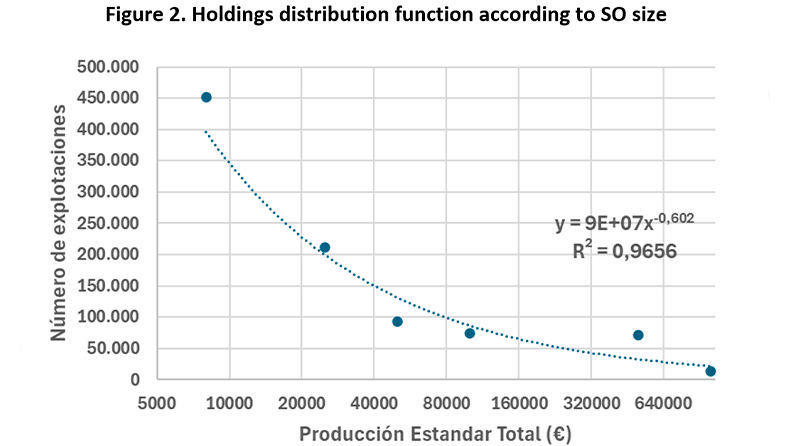
The arithmetic scale function has been drawn approximately (Figures 3 and 4) to perform the scenario analysis. We propose two scenarios to define points A and B. A first, less stringent scenario, MINIMUM Scenario, where point A would be set at €8,000 SO, the same threshold that FADN uses to define commercial farms, and €500,000 SO for point B (Figure 3), as these are the largest and mst profitable farms (see Table 1), and therefore we consider that they do not need income support.
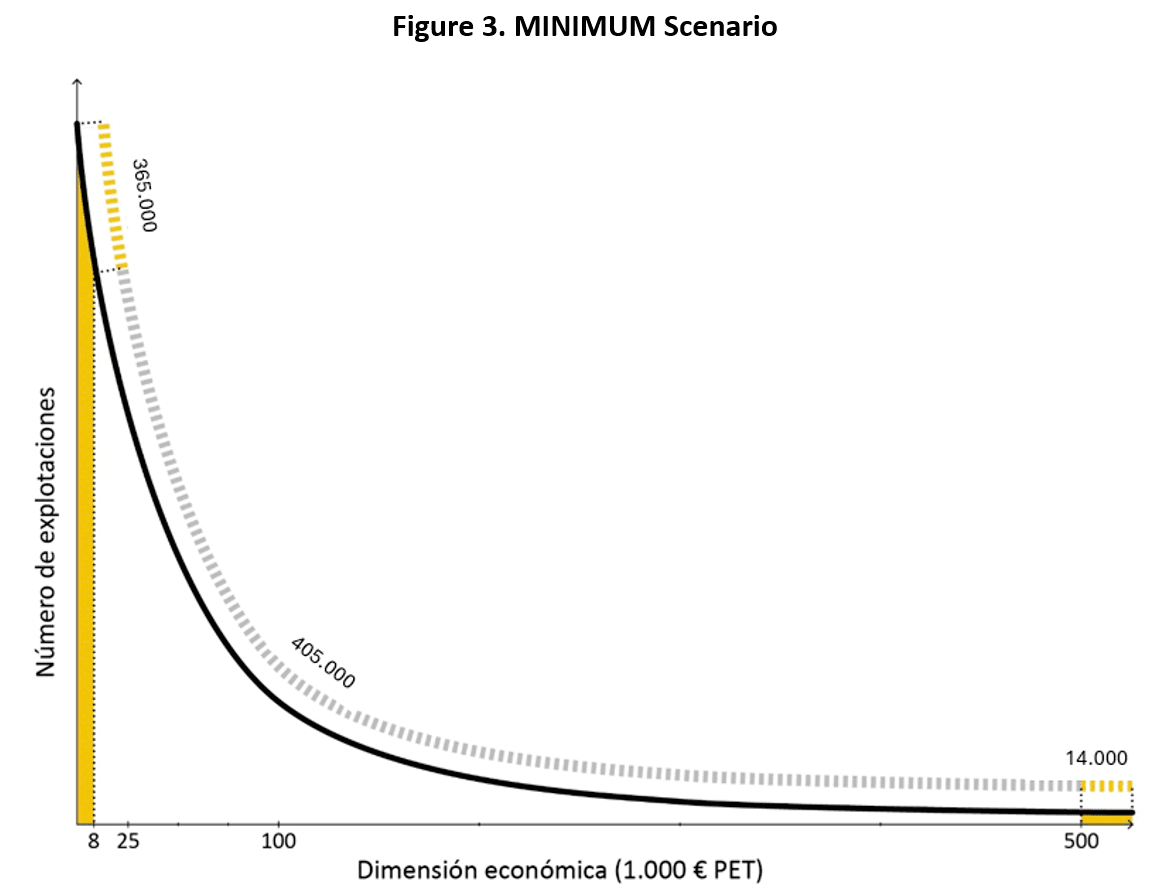
In this scenario, according to the 2023 Structural Survey, farms not entitled for CAP income support would be 365,000 in the yellow area to the left of €8,000 SO, and 14,000 in the yellow area to the right of €500,000 SO. There would be 405,000 farms between €8,000 and €500,000 SO eligible for income support, which is a significant number representing 52% of the total number of arms in the 2023 Structural Survey.
Fifty percent of farmers with farms to the left of point A are over 65 years of age and receive a retirement pension. According to the proposal of Regulation, these farmers will no longer receive income support by 2032. On the other hand, the farms to the left of point A will mostly be non-active farmers following the 20% minimum farming income over total income rule, so they would also be excluded from income support under that strict active farmer definition. However, the Regulation proposal does not establish that sort of definition and instead propose a general and ambiguous definition of active farm and leaves to the Member States to establish the concrete definition as in the previous period (2023-2027). In Spain rather of these non-active and very small-scale farmers, do not directly cultivate their land but is formally or informally transferred to other farmers or cooperatives that pay a land rent to the small farmer that is equivalent to the income support payment.
In the second and most severe scenario, the MAXIMUM scenario, point A would be set at €25,000 SO and point B at €100,000 SO (Figure).
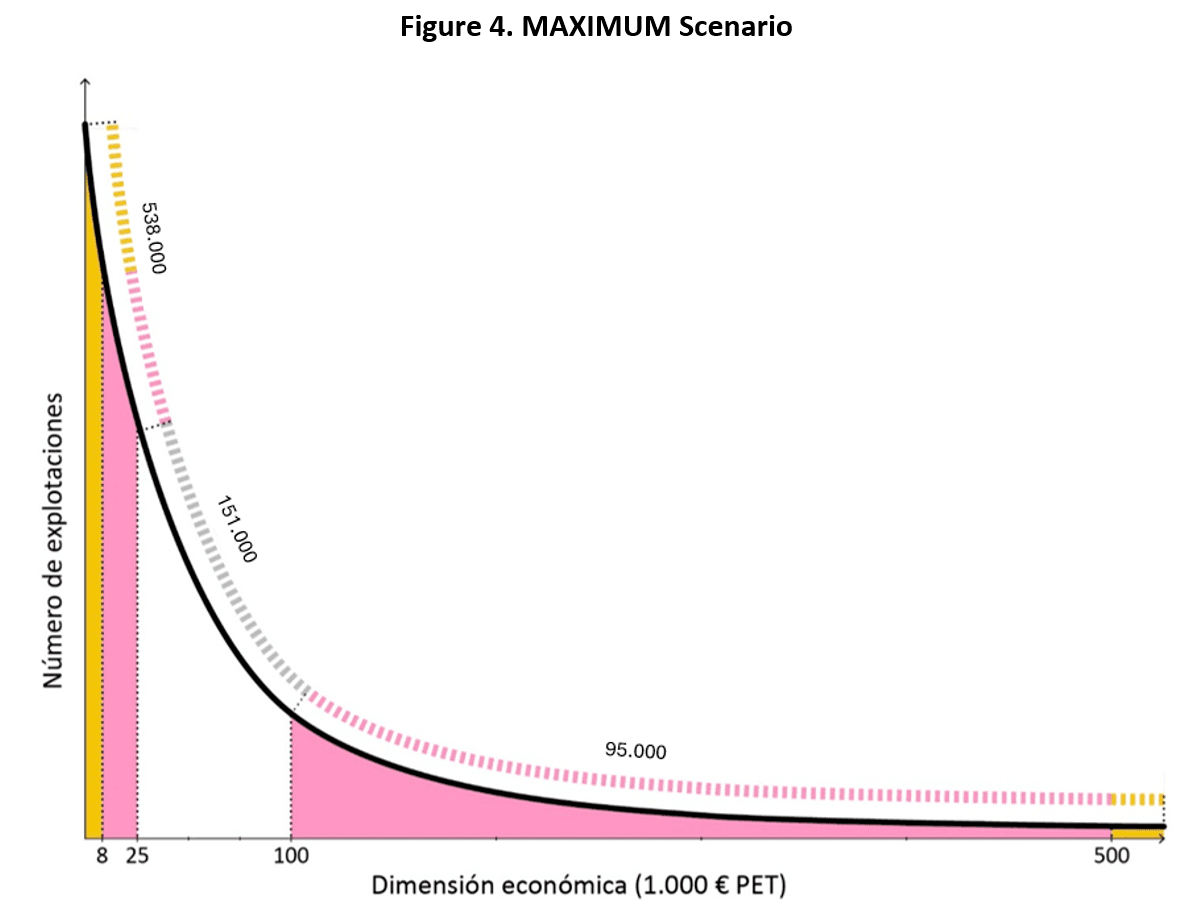
In this MAX scenario, the potential farms that would not be entitled to CAP income support would be, according to the 2023 Survey, 538,000 (yellow and purple area to the left of €25,000 SO), and 95,000 (yellow and purple area to the right of €100,000 SO), i.e., a total of 633,000 farms. There would be 151,000 farms between €25,000 and €100,000 SO. Farms excluded from income support in this MAX scenario would represent 81 % of the total number of farms, a large percentage of farms, while farms between €25,000 and €100,000 SO, on which income support would be focused, would represent only 19 % of the total number of farms, most of which can be assumed to be active farmers.
Therefore, it could be desirable to consider an intermediate scenario between the two scenarios defined as MINIMUM and MAXIMUM, establishing two thresholds within the area to the left of A. The first one at 8, 000 € SO (yellow area) without income support, and the second between 8,000 and 25,000 (purple area) where income support would only be reserved for young and new farmers and/or farms with an economic viability plan that could receive CAP income support to boost their improvement and modernization. Something similar could be done to the right of point B with two thresholds, one between €100, 000 and 500,000 SO (purple area) with income support, but applying a strict cap, and another above 500,000 (yellow area) without income support. In both sub-thresholds the farmers could of course receive payments for environmental services or support for investment in innovation and modernization.
As indicated at the beginning, the annual savings in income support expenditure which would be obtained through the proposed targeting, could be used to increase the budget for investment support, whether individual, corporate, or associative (producer organizations and/or cooperatives). This shift would facilitate a more innovation-oriented CAP and thus increase the competitiveness and sustainability of the agri-food sector. It could also be used to increase public support for risk management, as climate change is causing higher levels of risk in agriculture, and crisis management as it is increasingly necessary in such a complex and uncertain international context.
Estimating the annual savings in income support expenditure under the MIN, MAX, and intermediate scenarios is not easy, since the amount of income support received in each economic stratum must be determined, and the percentage of non-active farmers, who would also cease to receive income support, must be estimated in each economic stratum. As a rough guide to order of magnitude, since these are very preliminary estimates and therefore subject to serious reservations, the annual savings in expenditure would range from €202 million in the MIN scenario to €1.865 billion in the MAX scenario, with annual savings of €1.134 billion in an intermediate scenario. The savings are significant, as total income support in Spain amounts to €2.94 billion, meaning that the savings range from 7 % in the MIN scenario to 63 % in the MAX scenario, with 38 % in the intermediate scenario. These savings figures could increase if the proportion of non-active farmers, and who would therefore not receive income support, in farms positioned between A and B were high.
Discussion
It will be essential to investigate and analyse possible alternative scenarios to establish A and B thresholds, and possible sub-thresholds, of economic size, taking into account the Structural Survey 2023 and the FADN. This would allow estimating in each scenario how many farmers would be excluded from CAP income support, and especially what would be their main characteristics.
It is often argued in the case of farms to the left of A, that these small farmers can survive thanks to the CAP income support, and that their continuity is important to maintain a living rural environment. But there are several elements of doubt on such arguments. In the first place, the aid is very small, since it is per hectare and these farms are very small, so it seems difficult for them to survive thanks to this aid, when in addition most of these farmers are not active and therefore have income from other activities or a retirement pension. Moreover, these small farmers do not usually cultivate their land directly, but give it to other farmers in exchange for a payment or rent per hectare that is equivalent to the CAP aid, so they would continue to receive the CAP aid as income or rent from the land formally or informally transferred. In the event that small farmers who cease to receive income support directly cultivate their land, they could transfer their land through sale, lease or informal transfer to active farmers who would receive income support, thus recovering to some extent the lost income support. The increase in land mobility that would occur in order to partially or totally recover the lost income support, would have a positive effect on the improvement of the agricultural structure and the efficiency and competitiveness of the agricultural sector.
Secondly, as for the argument that these small farmers play an important role in maintaining a living rural environment, it should be confirmed by investigating whether or not these small farmers actually reside in the rural environment close to the farm. There is some evidence that small farmers, especially those already retired, leave the rural environment to move to urban areas.
In any case, eliminating farmers with less than €8,000 SO from income support only means a cost saving that we estimate at no more than €120 million/year, so it can be understood that the exclusion of these very small farmers from income support is a debatable issue given its political cost. An alternative would be to maintain the aid in this dimension stratum, but decreasing each year until its total disappearance at the end of the next CAP reform period.
In the case of farms to the right of B, it would be necessary to analyse using FADN the level of profitability and its variability along the last period from the different holding sizes and productive orientations, so as not to leave medium-large farms with reduced profitability due to the non-eligibility for income support. An alternative would be to maintain a capped income support instead non-eligibility and/or a decreasing payment along the next CAP reform period.
A balanced scenario would be that of two sub-strata within the area to the left of A, the smaller one not eligible for income support, and the larger one with support conditional on being a young or new farmer and/or submitting a viability plan. And also two sub-strata to the right of B, the upper one of very large farms not eligible for income support, and the lower one with large farms for which income support is maintained with capping and/or with income support decreasing each year until its total disappearance at the end of the next CAP reform period. Another option for this lower bracket of large farms would be that the income support be granted, only under the condition to be used for investments in farm innovation and modernization.
As for the possible criticisms of eliminating income support for large profitable farms, the main one is that agriculture is a high-risk activity due to climate change. Thus, the variability of farm income is high and income support plays an important role in income stabilization. But Spain has a very complete agricultural insurance system, and these farms are usually insured, and if not, they can be insured. Again, part of the savings in annual expenditure on income support could be devoted to improving risk management tools. On the other hand, in the case of crises and emergencies, which are increasingly frequent, as occurred with the pandemic in 2020, the severe droughts of 2022 and 2023, the war in Ukraine in 2022, or now in 2025 with the current trade war and tariffs imposed by the new US administration, there are public support mechanisms within and outside the CAP to which large farms could also have access.
Potentias consequences
The CAP shift proposed in this note might have potential consequences:
Income support should be focused for those farmers who are close to or already viable, but with a very tight profitability. Following the thread of this note, these would be the farms that fall between A and B. However, it could be considered that these aids should not be for an indefinite period, but for a sufficiently long period for these farms to consolidate their economic viability. It could even be considered to offer the option to capitalize them being paid at the beginning of the period as a capital to be invested in a viability or business plan.
If the elimination of income support to small farmers were to cause some situations of economic vulnerability, due to low incomes, especially for small farmers of advanced age or even already retired with very low retirement pensions, such situations should be addressed by means of social policy, not agricultural policy. On the other hand, and as we have already mentioned, small farmers who run out of income support could recover it, if they do not already do so, as income received from leasing or transferring their land to other farmers, since CAP income support is generally internalized as land rent, following the Ricardian theory.
In certain European territories with rural depopulation problems, such as it happens in Spain, the CAP income support may help to remain population in rural areas. Nevertheless, it is not obvious, since some of the recipients of this support do not live in rural areas, as can be investigated by checking the addresses declared by these recipients. In any case, the targeting of income support reinforces the need for a genuine and powerful rural development policy, but not only through the second pillar of the CAP, but also with all the EU structural policies. In the same way, specific aid for farmers in mountain and disadvantaged farming areas must be enhanced, as the Vision already proposes.
The elimination of income support to the left of A would surely make very small farms disappear, especially if combined with incentives for early retirement, which would increase land mobility, as these farms could lease or sell their land to active and larger farmers. This process would accelerate the structural change needed to improve the competitiveness and efficiency of the agricultural sector. In this sense, the proposal from the Vision to set a Land Observatory is an appropriated proposal. Regarding the possible social impact and depopulation of rural areas by eliminating income support to the small farms, see points 2 and 3 above.
Ineligibility or strong capping of income support to farms to the right of B, could lead to problems of income instability of large farms in certain sectors, as their profitability can vary greatly from year to year due to climatic or market crises. In addition, there are other kind of crises such as geopolitical crises, as the current tariff trade war waged by the Trump administration. Therefore, in the right of B but not only for these farms a powerful safety nets mechanisms must be established to deal with crises and emergencies, as the MFF and the proposal of Regulation proposes. These mechanisms should be coordinated with the risk management and income stabilization policies.
The effects of this proposal on the different agricultural sectors should be taken into account, since the profitability of farms varies not only according to the economic size of the farm but also to the productive orientation. Therefore, coupled aid should be strengthened in those sectors with serious profitability problems, or in productions desired to be developed to reduce EU dependences (protein crops) as the Vision itself proposes. In addition, it is suggested that for these sectors with profitability problems, although not only for these sectors, the model of support through producer organizations (POs), which have worked reasonably well in the fruit and vegetable sector, should be extended and consolidated.
Conclusion
The proposal for targeting income support contained in this note is an open proposal to be debated, and in fact, the main purpose of this note is to launch that debate. The thresholds A and B and possible sub-thresholds both to the left of A and to the right of B have to be decided, as well as whether to the right of B we should consider income support ineligibility or just capping. In our view eliminating income support to the very small farms, which are not active farm nor economically viable and to the very large farms that are already very profitable, and therefore do not need income support, should inspire post 2027 CAP. In addition to our proposal it might also be discussed whether would be appropriated to consider making the income support payments degressive as proposed by the Regulation proposal. The conclusion from this note would be to allocate less CAP budget to income support and more to incentives for environmental and climate services and support for investments in farm modernisation and innovation. This would be the best way to move forward to a sustainable and efficient agricultural sector.
A relevant objection to the Regulation proposal concerning targeting income support is the ambiguity in the definition of active farmer. Being an active farmer is an essential criterion for income support as what is the sense to grant income support to farmers whose income coming from farming activity is just a very small part (let say less than 20 %) of their total income. The Commission has left to the Member States the concretion of that ambiguous and general definition on active farmer, and the experience in the previous CAP period indicates that the Member Estates will be not very demanding in concreting that general definition.
The proposed changes in this note would be positive for improving the competitiveness of the agri-food sector, preserving the environment and mitigating climate change. At the same time, it would also be appropriate in view of the Ukraine's accession to the EU, since large farms, which account for a significant part of Ukrainian agriculture, would receive lower income support payments, though they could receive agro-environmental payments and support for investments on farm innovation and modernisation.
The trade war provoked by the current US administration as well as new crisis may cause negative impacts on the European agro-food sector, which will have to be addressed through specific support for the most affected stakeholders, sectors and products, and financed by the EU budget inside and outside of the CAP and national budgets. The current trade war and the new geopolitical context reinforces the need for the changes proposed in this note. On the one hand, the agricultural sector must improve its international competitiveness, to facing the Trump administration's tariffs. On the other hand, the CAP budget may have to be frozen or even reduced to meet other EU needs in a very difficult and uncertain geopolitical scenario, as in fact has been proposed in the MFF (Multiannual Financing Framework 2028-2034) issued on 16 July.

